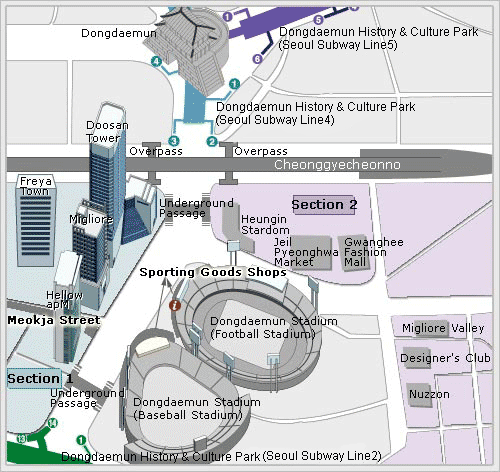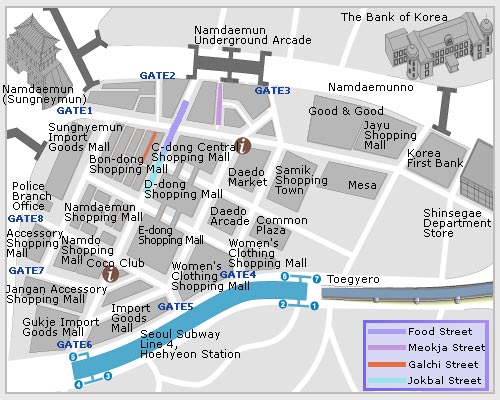fakes or cheap clothes you should definitely visit Dongdaemun Market orNamdaemun Market. Dongdaemun Market is open 24 hours. Many tourists like to visit the market late at night so you can see all the local vendors buying clothes for their shops or to try some of the food from the night vendors. Teenagers and young women visit Ewha Fashion Street for the latest styles and fashions. In this area Ewha Womans University, Yonsei University and Sogang University are located here making it an ideal location for inexpensive shoes and cheap clothing.
Myeongdong (명동) is one of the primary shopping districts in Seoul. The two main drags meet in the center of the block with one beginning from Myeongdong Subway Station (Seoul Subway Line No. 4) and the other from Lotte Department Store at Euljiro. Many brand name shops and department stores line the streets and alleys. Common products for sale include clothes, shoes, and accessories. Unlike Namdaemun or Dongdaemun, many designer brands are sold in Myeongdong. In addition, several major department stores include Lotte Department Store, Shinsegae Department Store, Myeongdong Migliore, Noon Square and M Plaza. The department stores carry many premium labels and other fashionable goods at reasonable prices.
Myeongdong also has family restaurants, fast food, plus Korean, Western and Japanese dining options. Many restaurants in Myeongdong specialize in pork cutlet (donkas) and kalguksu (thick noodles). Other businesses include hair salons, banks and theaters. Myeongdong Catholic Church is also a well-known tourist attraction. It is pillar of the Catholic church in Korea and was built in the Gothic style. Behind the church is a quiet space for relaxation.
| Directions |
| [Subway] Myeongdong Station (Seoul Subway Line 4), Exit 5, 6, 7, or 8. Euljiro Il-ga Station (Seoul Subway Line 2), Exit 5. |


Dongdaemun Market
Ever since its opening in 1905, Dongdaemun Market has been one of the major markets in Korea. Specializing in wholesale clothing, the market has grown large, having more than 20 shopping malls. A full range of fashion items that cover head to toe, are found in Dongdaemun Market at inexpensive prices. Just name it and you shall find it! No wonder the market is always crowded with retailers, foreigners, customers and tourists.
| Section 1 - Retail Shops The main street divides Dongdaemun Market into two sections. Section 1 is on the side where Doosan Tower is found, and Section 2 is on the side of Dongdaemun Stadium (see the map below). Huge shopping malls in Section 1 basically sell wholesale and retail goods, but mostly deal with general customers and tourists at retail prices. Thus, they have convenient facilities like money exchanges and information desks with English speaking staff. Opening hours are also aimed at general customers, opening from 10 am to 5 am the next day. With a pleasant interior, and rhythmical music played all day long, shopping malls in Section 1 draw many young people everyday. Various events organized by these shopping malls (7 or 8 pm) are also delightful. Sometimes you will get to see youth come up on the stage in front of the mall, dancing or singing. Major shopping malls are Doosan Tower, Migliore, Freya Town and Hello apM. | ||
| Section 2 - Wholesale Shops Shopping malls in Section 2 sell goods both in wholesale and retail, but mainly sell in bulk. That is why shopping malls here usually open at about 8 pm and close at 8 am or 5 pm the next day for the convenience of wholesalers. The peak time comes late at night through early morning. Since most shops deal with wholesalers, there are no dressing rooms. Refunds and exchanges are not guaranteed, so make sure to check the quality and size carefully. Major shopping malls in Section 2 are Designer's Club, Migliore Valley, Nuzzon, Gwanghee Fashion Mall, Jeil Pyeonghwa, and Heungin Stardom. Among them, Jeil Pyeonghwa and Heungin Stardom attract customers in their thirties and forties with items of simple and elegant design. Teens and youth in their twenties usually visit Designer's Club, Migliore Valley, Nuzzon and Gwanghee Fashion Mall. |

Namdaemun Market
Namdaemun Market, located in the very center of Seoul, is the biggest traditional market in Korea selling children's clothing, men & women's clothing, daily miscellaneous goods, kitchenware and local and imported products. Most shops have their own factories and make the products themselves offering both wholesale and retail prices which enable visitors to purchase various shopping items at extremely inexpensive prices. Foreign visitors to Namdaemun Market show different tastes: the Japanese are more into foods like gim (seaweed), gimchi, and ginseng, while the Chinese show interest in clothing and miscellaneous goods. On the other hand, most tourists from the West simply enjoy the ambience of the traditional market. Hours vary by store, so it's advisable to plan in advance according toa shopping list before you start actual shopping.

noryangjin fish market
in the very center of Seoul lies Noryangjin Fish Market, a market that is open 24 hours a day. The market is still very active from 1 a.m. til dawn, and 5 a.m. here is as bustling as Myeongdong in mid-afternoon.
As the country's largest wholesale fisheries market, Noryangjin Fish Market sees several thousand people everyday; about 4,000 people who work here on a regular basis and about 30,000 customers who filter in and out throughout the day.
Noryangjin Fish Market is the best place in Seoul to get fresh seafood at competitive prices. Various types of marine produce are gathered here from all over the nation and distributed out to markets via the auctions that are held here. The market is both a wholesale outlet, trading in daily catches that arrive from every possible location, and also a retail market, where the public can get the freshest seafood at very low prices. Moreover, there are many restaurants lining the market which serve hoe (raw fish; pronounced "hwae") so you can enjoy fresh hoe while visiting.
For those of you who aren't familiar with "hoe" may recognize it's Japanese counterpart, "sashimi". They are essentially the same, both being thinly sliced raw fish, or other raw seafood. Just like in Japan, hoe is an extremely popular food, so you can enjoy it not only in the fish market, but at one of the many hoetjip (hoe restaurant) in Seoul.
Although raw fish is enjoyed in both Korea and Japan, there are cultural differences between the two. For example, Koreans prefer hwal-eo hoe, fish that has been freshly caught and eaten straight away. However in Japan, they prefer seon-eo hoe, fish that has been freshly caught and killed straight away and kept fresh on ice for several days.
Also, in Korea, fish with a lot of solid, white flesh is popular, whereas in Japan, fish with soft, red flesh and a lot of fat is popular.
Another difference is in the way raw fish is consumed. In Japan, raw fish is usually dipped in soy sauce with wasabi, whereas in Korea raw fish is usually dipped in not only soy sauce with wasabi, but in chogochujang (red chili pepper paste and vinegar), ssamjang (sesame oil, garlic, soybean paste) as well.
And lastly, in Japan, sushi (raw fish and rice) is more popularly eaten than sashimi, whereas in Korea it is the opposite; Koreans eat hoe more than chobap (Korean equivalent of sushi).
Fish by the SeasonNo matter what time of the year you go to Noryangjin Fish Market, there is always an abundant amount of marine produce, but the varieties of produce available may vary by season.
In the winter, flathead mullet (숭어), yellowtail (방어), Spanish mackerel (삼치), chambok (참복), halibut (넙치), octopus (참문어), and snow crabs (대게) are in season.
In the spring, flounder (가자미), Spanish mackerel (삼치), black sea bream (감성돔), snapper (참돔), parrot fish (돌돔), hakkkongchi (학꽁치), chammuneo (참문어), and prawns (보리새우) are in season.
In the summer, eel (붕장어), hwangdom (황돔), bass (농어), parrot fish (돌돔), grouper (능성어), filefish (말쥐치), and abalone (전복) are in season.
In the fall, dotted gizzard shad (전어), mackerel (고등어), skate (홍어), filefish (말쥐치), sil squid (실오징어), and small octopus (낙지) are in season.
When Koreans eat various types of raw fish in one meal, they usually start with the fish with white flesh first (e.g. halibut, parrot fish, seabass) and then finish off with the fish with red flesh (e.g. yellowtail, tuna, mackerel).
At Noryangjin Fish Market, not only can you get fresh fish, you can various types of seafood including scallops, clams, squid, oysters, conch, sea squirt, sea slugs, marine spoon worm, etc. However, out of the seafood available at the market, the most interesting one for foreigners is most likely sannakji, or "live octopus".
How to Order and Enjoy a Meal at Noryangjin Fish MarketThe first thing you do is figure out what sort of fish and seafood you would like to have for your meal. Once you've decided you can peruse the different stalls to see what sort of marine produce they offer, and then buy from them directly.
Prices vary by type of fish or seafood, by season, and by weight. This is where having good haggling skills works in your favor. But of course, if you can't speak Korean, this can get a bit difficult, but many of sellers will work to communicate with you. Try and get an idea of the prices for the fish and seafood you want beforehand, so that you can try and get a good price. On average you can expect to pay about 20,000 - 40,000 won per person. (But then again, if you decide to purchase A LOT of fish, it will cost you more).
Once you have made your purchase, the seller will slice up the fish into hoe right in front of you. The pieces that don't get cut up for hoe aren't thrown away however, as they are used to make maeuntang (spicy fish stew), so don't be surprised when they package up the remnant bits for you too.
Now that you have your hoe ready to go, the next step is to select one of the many restaurants located within the market. Many times the fish stall seller will recommend a restaurant to you if you don't know of one already.
Once at the restaurant, go ahead and give your fish purchases to the waitress and let him/her know how you want it; as is (hoe-style), cooked, in a soup, etc. (however normally people request to eat the fish as is) so that the restaurant can prepare it for you. The great thing about these restaurants is that you can conveniently eat your food at a table. The tables are usually set up with sauces, marinades, perilla leaves, lettuce, and some vegetables that you can eat your fish with. Expect to pay about 3,000 - 5,000 won per person.
How to Get There
Take subway line 1 to Noryangjin Station. Go out exit 1 and walk for about 520 meters. Or you can take subway line 9 to Noryangjin Station, go out exit 1 and walk about 290 meters.

















Hi there, I read your blogs on a regular basis. Reading this post reminds me of my previous room mate! He always kept chatting about this. Thanks for sharing.
ReplyDelete_______________________
Online Women Bags Qatar